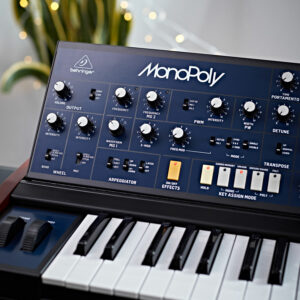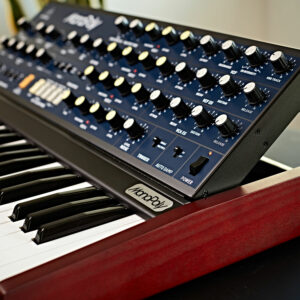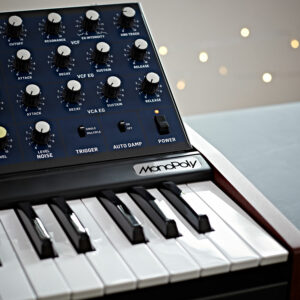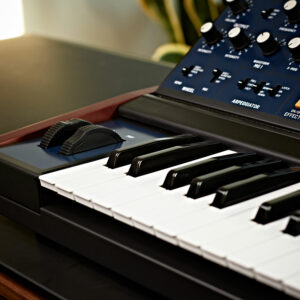Behringer have become known for their faithful recreations of vintage synths – often obscure ones which have been difficult to obtain for years. This is the case with the Behringer MonoPoly, which brings a classic ’80s design into the 21st century.
Like a lot of synthesizers, the MonoPoly looks a bit daunting at first. But after a little time with it, I found this not to be the case. In fact, I think it’s ideal for beginners who are starting to learn more about synthesis and want more than just a basic monophonic synthesiser.
And even if you are a seasoned pro, you’re sure to get a lot out of the MonoPoly. You’ll find lots of ways to shape your sound along with a few interesting quirks which are unique to this synth. So really, there’s something for everyone with it.
I’ve had a go with the MonoPoly myself and had a great time with it. Here are some of my thoughts on it.
Initial thoughts
 At first – as I’ve mentioned – I found the MonoPoly a bit daunting. But that’s the case for all synthesizers!
At first – as I’ve mentioned – I found the MonoPoly a bit daunting. But that’s the case for all synthesizers!
Despite this initial synth-shock, I found it remarkably easy to get my head around.
Even without the very handy quick-start guide (which I do recommend reading – whether you think you know it all, like me, or not), I was able to start crafting interesting sounds right out of the box.
Each section is clearly laid out, and – because it’s all-analog – there are no pesky menus to dive into.
Something else I noticed on first impression was the full-sized keyboard with a three-octave range.
In an era of mini keyboards (and even no keyboards), this was refreshing to see. It’s also something that might make this synth a little more appealing to keys players.
And just a quick word about the design: I really like the blue colour and wooden side panelling. Ok. Back to synth talk.
Form your sound with the VCOs and Key Assign Mode
So, this is a polyphonic synth with four voices (compromised of the four VCOs). True. But beyond this, there’s a lot of possibility for how you configure that. It’s all thanks to the voice-assign section which I found pretty intuitive to use.
VCO section
 The Behringer MonoPoly has four VCOs to work with. Each can be adjusted independently with a few different controls.
The Behringer MonoPoly has four VCOs to work with. Each can be adjusted independently with a few different controls.
There’s a master tune control that is tethered to VCO 1. The other VCOs have independent tuning capabilities – great for creating fatter synth sounds, especially when in a monophonic mode.
Each oscillator has four different options for waveforms: triangle, sawtooth, pulse-width modulation, and pulse-width.
The latter two can be controlled with separate PW and PWM sections. This allows you to create some interesting pulse-width and cross-modulation sounds, beyond the standard straight-forward waveforms.
As well as this, there’s an octave control and level control, allowing you to mix in the four VCOs how you want to.
Key Assign section
With the buttons in the Key Assign section, there are a number of options for how you assign the VCOs to the different keys. The most basic is the Unison mode. This is a monophonic mode (you can only play one note at a time) which assigns all of the VCOs to the currently pressed key. I found this a great mode to create cool bass sounds with.
The Unison/Share mode will share out the oscillators evenly between the keys you’re playing. So if you play one note, it will assign all oscillators to this note. If you play two, it will assign two to each. Three notes, it will assign two to one, and then one to two. And then for four notes, it will assign one oscillator to each key. Woah! That’s a lot of numbers.
The Poly mode is like the Unison/Share mode, but each key – up to four keys – will always have a single VCO assigned to it. This is maybe how you would expect a normal keyboard to behave – especially if you set all the VCOs to a similar setting. Or you could go weird with it and have them all set to different octaves, volumes, tunings, and waveforms. Why don’t you go for it?
One particular mode I really like is the Chord Memory mode. This remembers a chord you play and then allows you to play it back with a single note. So it’s essentially a monophonic mode but just a bit more fun.
There’s also a Hold function for retaining notes after you press the key, which can be useful when shaping your sound or creating a deep drone.
Shape your sound with the VCF, VCF EG, and VCA EG
 The MonoPoly’s VCF is great for further shaping your synth sound. It’s a low-pass filter, and this gives you a lot of flexibility to make the VCOs sound brighter or duller.
The MonoPoly’s VCF is great for further shaping your synth sound. It’s a low-pass filter, and this gives you a lot of flexibility to make the VCOs sound brighter or duller.
When combined with the VCF envelope generator, you can make much more dynamic sounds. For example, you can dial up the resonance on the VCF, and then set a high attack on the VCA and a low decay for a squelchy bass sound.
This is something you’ll want to explore yourself as you can get lots out of it.
There’s also the VCA envelope generator. This controls the amplitude over time of your sound and features the standard ADSR controls of most synths.
You can use this to change the character of your sound pretty easily. Do you want a short, plucky sound? Or do you want a slow-building pad? The VCA envelope generator is the area to edit this.
When combined together, the VCA and VCF envelope generators are great for creating more interesting sounds that change over time.
Performability and expression wheels
 The keybed is full-sized and spread over three octaves. This means it’s great for performance as it gives you a decent range with normal-sized keys. So if you’re a keyboardist first and a synthesist second, you’ll feel right at home using the MonoPoly.
The keybed is full-sized and spread over three octaves. This means it’s great for performance as it gives you a decent range with normal-sized keys. So if you’re a keyboardist first and a synthesist second, you’ll feel right at home using the MonoPoly.
Plus, you’re able to tilt the whole synth upwards if you need to for better access to controls while you’re playing – essential if you want to change settings on the fly with ease.
Extra performability is possible with this synth thanks to two expression wheels.
The bend wheel is spring-loaded and can be used to affect two different parts of the synth – the main (VCO 1) pitch or the cutoff of the VCF.
You can use the bend wheel for pitch bending capabilities or to temporarily change the tone of your sound. Because it’s spring-loaded, once you’ve changed a setting, it will go back to its default position.
The MG1 wheel, however, doesn’t have a spring. It can be used to alter the same modulations but will stay the same when you move it, with its lowest position being the default rather than the middle.
As well as this, there are intensity controls, so you can easily change how much the wheels affect their chosen settings.
Final thoughts
I found the Behringer MonoPoly a really fun synth to play. Not only is it immensely performable, but you also get a lot of options for sonic manipulation while playing it. So, all in all, it’s a great synthesizer for beginners and experts alike and is worth checking out sometime.













0 Comments